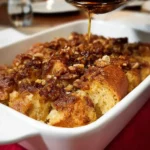Of all the brunch recipes I’ve pulled out for holidays and lazy Sunday mornings, none receive the same level of unanimous, blissful sighs as this Make-Ahead French Toast Casserole. The first time I made it was for a chaotic Christmas morning. The idea of standing over a hot skillet, dipping and flipping individual slices of French toast while my family was eagerly waiting to open presents, felt like a special kind of holiday stress I wanted no part of. This recipe was my secret weapon. The night before, amidst the quiet hum of the dishwasher and the twinkle of the tree lights, I spent a mere 15 minutes cubing bread and whisking together a fragrant, cinnamon-spiced custard. The next morning, all I had to do was preheat the oven and slide the pan in. The house slowly filled with the most incredible aroma—warm cinnamon, sweet vanilla, and rich, baking bread. When I pulled out the golden-brown, puffed-up casserole, crispy on top and unbelievably soft and pudding-like underneath, it felt like I had performed some sort of kitchen magic. My family devoured it, and it has since become our non-negotiable tradition for any and every special occasion. It’s the ultimate stress-free, crowd-pleasing breakfast that delivers a “wow” factor with minimal morning-of effort.
The Ultimate Make-Ahead French Toast Casserole
This recipe is designed for a standard 9×13-inch baking dish and is perfect for serving a crowd. The magic lies in the overnight soak, which allows the bread to fully absorb the rich custard, resulting in a perfectly textured dish that’s never dry or overly soggy.
Ingredients
For the Casserole:
- Bread: 1 large loaf (about 1 to 1.5 pounds) of Challah, Brioche, or a sturdy French bread, preferably a day or two old, cut into 1-inch cubes.
- Eggs: 8 large eggs
- Milk: 2 cups of whole milk
- Heavy Cream: 1 cup of heavy cream (or use all milk for a lighter version)
- Granulated Sugar: 1/2 cup of granulated sugar
- Brown Sugar: 1/4 cup of packed light or dark brown sugar
- Vanilla Extract: 2 teaspoons of pure vanilla extract
- Cinnamon: 2 teaspoons of ground cinnamon
- Nutmeg: 1/2 teaspoon of freshly grated or ground nutmeg
- Salt: 1/4 teaspoon of salt
- Butter: 2 tablespoons of unsalted butter, melted, for greasing the dish
For the Cinnamon-Sugar Topping (Optional but Recommended):
- Brown Sugar: 1/4 cup packed light or dark brown sugar
- All-Purpose Flour: 1/4 cup all-purpose flour
- Cinnamon: 1 teaspoon ground cinnamon
- Butter: 4 tablespoons (1/2 stick) of cold unsalted butter, cut into small pieces
- Pecans or Walnuts: 1/2 cup chopped pecans or walnuts (optional)
Instructions
Crafting this casserole is a simple two-part process: the easy prep work the night before and the simple bake the next morning.
Part 1: The Night Before (15 Minutes of Prep)
- Prepare the Baking Dish: Generously grease a 9×13-inch baking dish with 2 tablespoons of melted butter, ensuring you cover the bottom and all sides. This prevents sticking and adds a rich flavor to the crust.
- Arrange the Bread: If you haven’t already, cut your day-old bread into 1-inch to 1.5-inch cubes. Don’t worry about perfect uniformity; a little variation adds to the texture. Spread the bread cubes in an even layer in the prepared baking dish. It’s okay if they are snug.
- Create the Custard: In a large mixing bowl, crack the 8 large eggs. Whisk them vigorously until the yolks and whites are completely combined and slightly frothy, about 1 minute.
- Add Liquids and Seasonings: To the whisked eggs, add the whole milk, heavy cream, granulated sugar, brown sugar, vanilla extract, cinnamon, nutmeg, and salt. Whisk everything together until the sugar is dissolved and the mixture is homogenous and fragrant. This should take another minute of steady whisking.
- Soak the Bread: Carefully and slowly pour the custard mixture evenly over the bread cubes in the baking dish. Gently press down on the bread with a spatula or your hands to ensure every single piece is submerged and beginning to soak up the delicious custard.
- Cover and Chill: Cover the baking dish tightly with plastic wrap or aluminum foil. Place it in the refrigerator to soak overnight, or for at least 8 hours. This chilling period is crucial and cannot be skipped; it’s what transforms the bread and custard into a cohesive, flavorful bake.
Part 2: The Morning Of (Baking the Casserole)
- Preheat and Prepare: In the morning, take the casserole dish out of the refrigerator and let it sit on the counter for about 20-30 minutes to take the chill off while your oven preheats to 350°F (175°C). This helps it bake more evenly.
- Prepare the Topping (If Using): While the oven preheats, prepare the streusel topping. In a small bowl, combine the brown sugar, flour, and cinnamon. Add the cold, cubed butter. Using your fingertips, a pastry blender, or two knives, cut the butter into the dry ingredients until the mixture resembles coarse crumbs with some pea-sized pieces of butter remaining. If using, stir in the chopped pecans or walnuts.
- Top the Casserole: Uncover the French toast casserole. Sprinkle the streusel topping evenly over the surface.
- Bake to Perfection: Place the casserole in the preheated oven and bake, uncovered, for 45 to 60 minutes. The casserole is done when the center is puffed up and set (a knife inserted into the center should come out clean), and the top is beautifully golden brown and crispy. If the top starts to brown too quickly before the center is cooked, you can loosely tent it with aluminum foil for the last 10-15 minutes of baking.
- Rest Before Serving: Let the casserole rest for 10-15 minutes before slicing and serving. This allows the custard to fully set, making it easier to serve clean, beautiful squares.
Nutrition Facts
- Servings: 10-12 servings
- Calories per serving: Approximately 450-550 kcal (This is an estimate and will vary based on the type of bread, whether you use cream, and the inclusion of the streusel topping and nuts).
Preparation Time
- Active Preparation Time: 15 minutes
- Chilling Time: 8 hours (or overnight)
- Baking Time: 45-60 minutes
- Resting Time: 10-15 minutes
- Total Time: Approximately 9 hours 30 minutes (with most of it being hands-off time)
How to Serve This Masterpiece
This Make-Ahead French Toast Casserole is a stunning centerpiece for any brunch table. While it’s divine on its own, a few simple additions can elevate it to a truly unforgettable meal. Think of the casserole as your canvas and the toppings as your paints.
- The Classics Bar: Set up a small station with classic French toast accompaniments.
- Pure Maple Syrup: A high-quality, warm maple syrup is non-negotiable for many.
- Powdered Sugar: A light dusting just before serving adds a touch of elegance.
- Softened Butter: A small pat of butter that melts into the warm casserole is pure comfort.
- Fresh and Fruity: Bright, fresh fruits cut through the richness of the casserole beautifully.
- Berry Medley: A simple bowl of fresh strawberries, blueberries, raspberries, and blackberries adds color and a tart contrast.
- Caramelized Bananas: Quickly sauté sliced bananas in a little butter and brown sugar until soft and caramelized for a decadent, warm topping.
- Warm Apple Compote: Simmer diced apples with a splash of water, cinnamon, and a touch of maple syrup until tender. It’s like a hug in a bowl.
- Creamy and Crunchy Delights: Add another layer of texture and flavor.
- Freshly Whipped Cream: Lightly sweetened whipped cream makes every bite feel even more luxurious.
- Toasted Nuts: If you didn’t include them in the streusel, have a bowl of toasted pecans, walnuts, or slivered almonds on the side for a nutty crunch.
- Yogurt or Crème Fraîche: A dollop of tangy Greek yogurt or smooth crème fraîche offers a sophisticated, tangy counterpoint to the sweetness.
- Creating a Full Brunch Spread: To turn this casserole into a complete feast, pair it with savory sides.
- Salty Meats: Crispy bacon, savory sausage links or patties, or slices of baked ham perfectly complement the sweet casserole.
- Eggs: A side of simple scrambled eggs or a frittata ensures there’s something for everyone.
- Fresh Juices & Coffee: Don’t forget freshly squeezed orange juice and a pot of hot, strong coffee or tea to round out the meal.
Additional Tips for French Toast Casserole Perfection
After making this recipe dozens of times, I’ve gathered a few key tips that guarantee success every single time.
- The Bread is Everything (No, Really): The single most important factor for achieving the perfect texture is using the right kind of bread, and making sure it’s stale. A soft, enriched bread like Challah or Brioche is ideal because its eggy, buttery structure can absorb the custard without turning to complete mush. French bread also works well. Avoid standard, pre-sliced sandwich bread at all costs; it’s too soft and will disintegrate, leading to a soggy, sad casserole. If your bread is fresh, you can “stale” it yourself: simply cube it and spread it on a baking sheet, then bake at 300°F (150°C) for 10-15 minutes, or just leave it out on the counter for several hours. Dry bread is thirsty bread!
- Don’t Rush the Soak: I cannot stress this enough: the overnight (or minimum 8-hour) soak is non-negotiable. This is where the magic happens. It gives the bread time to slowly and fully absorb the custard deep into its core. A rushed soak will result in a casserole with dry spots in the middle and a layer of unabsorbed custard at the bottom. Be patient; the reward is a perfectly consistent, creamy, bread-pudding-like texture throughout.
- Master the Custard Ratio: The balance of eggs to dairy is crucial. Too few eggs and the casserole won’t set properly, leading to a soupy mess. Too many eggs and it can become overly dense and taste eggy. The ratio in this recipe (8 eggs to 3 cups of dairy) is carefully tested to create a rich, creamy custard that sets up firmly but remains tender. For the richest flavor, use the combination of whole milk and heavy cream. If you want to lighten it up, you can use all whole milk, but avoid skim milk as the lack of fat will result in a less satisfying texture.
- Embrace the Streusel Topping: While the casserole is delicious on its own, the optional streusel topping is what truly takes it over the top. It provides a delightful textural contrast—a crunchy, sweet, buttery, and slightly crispy layer against the soft, yielding casserole beneath. It’s the difference between a good French toast casserole and a great one. The cold butter is key to a crumbly streusel, so don’t let it soften. It adds only 5 minutes of prep time and pays off tenfold in flavor and texture.
- Know When It’s Perfectly Baked: The biggest fear is serving an undercooked, runny casserole. Use visual and physical cues to check for doneness. The casserole should be visibly puffed up, especially in the center, and the entire top surface should be a deep golden brown. To be absolutely sure, insert a thin knife or a skewer into the very center of the casserole. It should come out clean, with no wet, uncooked custard clinging to it. If the top is browning too fast but the center is still wet, loosely tent the dish with aluminum foil and continue baking until the center is set.
Frequently Asked Questions (FAQ)
Here are answers to some of the most common questions about making this fantastic brunch dish.
1. Can I prepare and bake this on the same day?
While the “make-ahead” nature is one of its best features, you can make a same-day version if you’re short on time. For the best results, you still need a minimum soaking time of 2-4 hours. Prepare the casserole as directed, cover, and refrigerate for as long as you can within that window. Gently press the bread down into the custard a few times during the soak to encourage absorption. The texture may be slightly less uniform than the overnight version, but it will still be incredibly delicious.
2. Why is my French toast casserole soggy on the bottom?
Sogginess is usually caused by one of two things: using the wrong bread or an imbalanced custard. If you use a soft, flimsy bread like sandwich bread, it simply cannot hold its structure when saturated with liquid. It breaks down and creates a dense, soggy layer. The other culprit is too much liquid for the amount of bread. Make sure you use a full 1 to 1.5-pound loaf. If your loaf is on the smaller side, you might consider slightly reducing the milk or cream to compensate. Using stale, dry bread is your best defense against a soggy bottom.
3. Can I freeze this French toast casserole?
Yes, this casserole freezes beautifully! You have two options:
- Freeze Unbaked: Assemble the entire casserole as directed (without the streusel topping), cover it tightly with a layer of plastic wrap and then a layer of aluminum foil, and freeze for up to 2 months. When ready to bake, transfer it to the refrigerator to thaw overnight. In the morning, let it sit at room temp for 30 minutes, add the fresh streusel topping, and bake as directed (it may need an extra 5-10 minutes).
- Freeze Baked: Bake the casserole completely and let it cool to room temperature. You can freeze it whole or cut it into individual portions. Wrap it tightly in plastic wrap and foil and freeze for up to 2 months. Reheat from frozen in a 350°F (175°C) oven, covered with foil, for 20-30 minutes, or until warmed through.
4. How do I make this recipe dairy-free?
It’s very easy to adapt this recipe to be dairy-free. Simply substitute the whole milk and heavy cream with your favorite unsweetened, full-fat plant-based milks. A combination of almond milk and full-fat canned coconut milk (the thick part) works wonderfully to replicate the richness of dairy. You will also need to use a dairy-free butter alternative (like a good quality margarine or coconut oil) to grease the dish and for the streusel topping. Ensure your bread is also dairy-free (Challah is typically not, so a vegan brioche or French loaf is a better choice).
5. Can I add fruit or other mix-ins directly into the casserole?
Absolutely! This is a great way to customize your casserole. You can fold about 1 to 1.5 cups of fruit or other additions into the bread cubes before you pour over the custard. Some great options include:
- Berries: Blueberries or chopped strawberries.
- Fall Flavors: Diced apples or pears, along with a handful of dried cranberries.
- Cream Cheese: Dollop small cubes of softened cream cheese throughout the casserole for tangy, creamy pockets.
- Chocolate: A cup of chocolate chips will turn this into an even more decadent treat.
Be aware that adding fruit with high water content (like fresh berries) can sometimes add extra moisture, so ensure your bread is nice and dry to start.

Make-Ahead French Toast Casserole Recipe
Ingredients
For the Casserole:
- Bread: 1 large loaf (about 1 to 1.5 pounds) of Challah, Brioche, or a sturdy French bread, preferably a day or two old, cut into 1-inch cubes.
- Eggs: 8 large eggs
- Milk: 2 cups of whole milk
- Heavy Cream: 1 cup of heavy cream (or use all milk for a lighter version)
- Granulated Sugar: 1/2 cup of granulated sugar
- Brown Sugar: 1/4 cup of packed light or dark brown sugar
- Vanilla Extract: 2 teaspoons of pure vanilla extract
- Cinnamon: 2 teaspoons of ground cinnamon
- Nutmeg: 1/2 teaspoon of freshly grated or ground nutmeg
- Salt: 1/4 teaspoon of salt
- Butter: 2 tablespoons of unsalted butter, melted, for greasing the dish
For the Cinnamon-Sugar Topping (Optional but Recommended):
- Brown Sugar: 1/4 cup packed light or dark brown sugar
- All-Purpose Flour: 1/4 cup all-purpose flour
- Cinnamon: 1 teaspoon ground cinnamon
- Butter: 4 tablespoons (1/2 stick) of cold unsalted butter, cut into small pieces
- Pecans or Walnuts: 1/2 cup chopped pecans or walnuts (optional)
Instructions
Part 1: The Night Before (15 Minutes of Prep)
- Prepare the Baking Dish: Generously grease a 9×13-inch baking dish with 2 tablespoons of melted butter, ensuring you cover the bottom and all sides. This prevents sticking and adds a rich flavor to the crust.
- Arrange the Bread: If you haven’t already, cut your day-old bread into 1-inch to 1.5-inch cubes. Don’t worry about perfect uniformity; a little variation adds to the texture. Spread the bread cubes in an even layer in the prepared baking dish. It’s okay if they are snug.
- Create the Custard: In a large mixing bowl, crack the 8 large eggs. Whisk them vigorously until the yolks and whites are completely combined and slightly frothy, about 1 minute.
- Add Liquids and Seasonings: To the whisked eggs, add the whole milk, heavy cream, granulated sugar, brown sugar, vanilla extract, cinnamon, nutmeg, and salt. Whisk everything together until the sugar is dissolved and the mixture is homogenous and fragrant. This should take another minute of steady whisking.
- Soak the Bread: Carefully and slowly pour the custard mixture evenly over the bread cubes in the baking dish. Gently press down on the bread with a spatula or your hands to ensure every single piece is submerged and beginning to soak up the delicious custard.
- Cover and Chill: Cover the baking dish tightly with plastic wrap or aluminum foil. Place it in the refrigerator to soak overnight, or for at least 8 hours. This chilling period is crucial and cannot be skipped; it’s what transforms the bread and custard into a cohesive, flavorful bake.
Part 2: The Morning Of (Baking the Casserole)
- Preheat and Prepare: In the morning, take the casserole dish out of the refrigerator and let it sit on the counter for about 20-30 minutes to take the chill off while your oven preheats to 350°F (175°C). This helps it bake more evenly.
- Prepare the Topping (If Using): While the oven preheats, prepare the streusel topping. In a small bowl, combine the brown sugar, flour, and cinnamon. Add the cold, cubed butter. Using your fingertips, a pastry blender, or two knives, cut the butter into the dry ingredients until the mixture resembles coarse crumbs with some pea-sized pieces of butter remaining. If using, stir in the chopped pecans or walnuts.
- Top the Casserole: Uncover the French toast casserole. Sprinkle the streusel topping evenly over the surface.
- Bake to Perfection: Place the casserole in the preheated oven and bake, uncovered, for 45 to 60 minutes. The casserole is done when the center is puffed up and set (a knife inserted into the center should come out clean), and the top is beautifully golden brown and crispy. If the top starts to brown too quickly before the center is cooked, you can loosely tent it with aluminum foil for the last 10-15 minutes of baking.
- Rest Before Serving: Let the casserole rest for 10-15 minutes before slicing and serving. This allows the custard to fully set, making it easier to serve clean, beautiful squares.
Nutrition
- Serving Size: One Normal Portion
- Calories: 450-550 kcal





